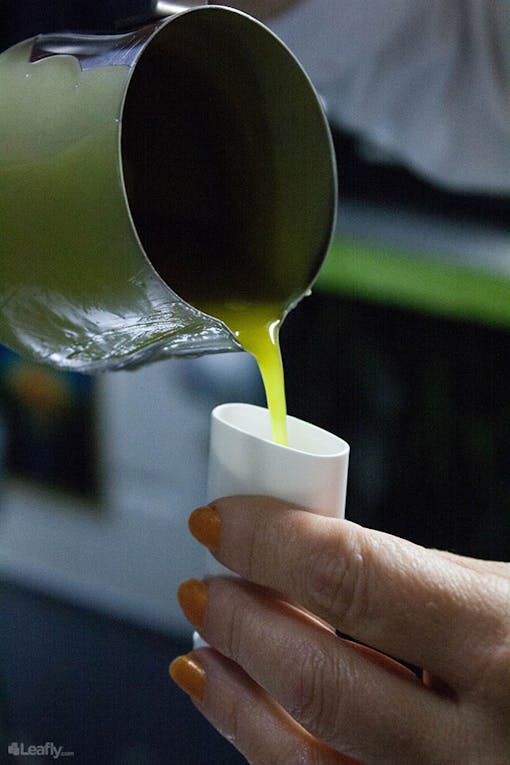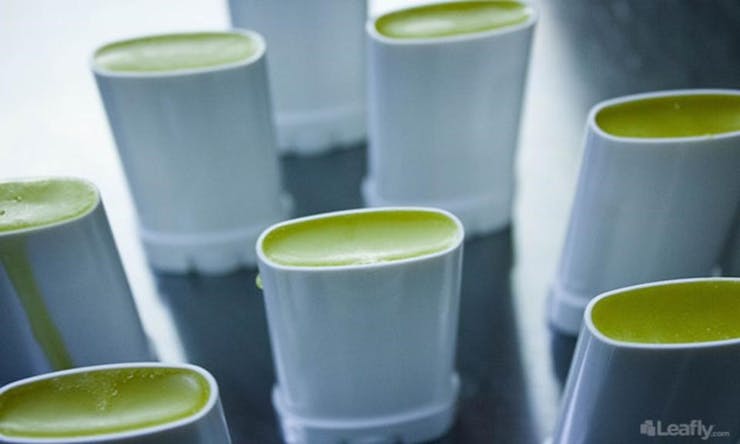The skincare industry has a new secret weapon: cannabis. Though hemp seed oil was used as a topical medicine throughout the 18th century, cannabis as topical medicine was almost completely forgotten with the rise of modern medical technologies. Now, due to the rise in popularity of medicinal marijuana, cannabis creams are making a major comeback, with some even selling for a whopping $500 per five ounce container. But, what’s all the hype about? Do cannabis-infused creams actually work?
To help Leafly readers understand what cannabis-infused topicals are and how they work, we’ve enlisted the help of Aimee (Ah) Warner of Cannabis Basics, a Seattle-based topicals company, to share some of her skincare expertise.

Ah Warner, owner of Cannabis Basics and maker of cannabis topicals.
Warner has been in the hemp industry since the early 1990s, when she was inspired to develop her own line of hemp-based skincare products while she was pregnant with her daughter.
“Nothing out there was exactly what I was looking for,” she said. Other products were filled with synthetic ingredients and nothing was quite gentle enough for the sensitive skin of her newborn daughter. Unsatisfied with the available options, Warner took matters into her own hands and created a line that was filled with 100% natural and organic ingredients.
In the beginning Warner stuck to what she knew best: products containing imported hemp seed oil. Hemp seed oil is known for its volatility and difficulty to work with. When using hemp seed oil in skin care products, it’s important that you stick to a very precise temperature range in order to prevent it from burning.
“I use hemp seed oil because it has the perfect balance of omega-3 and omega-6 fatty acids,” explained Warner. “Even though the oil is difficult to work with, the fatty acids are just so good for your body.” Essential fatty acids (EFAs) are crucial nutrients which the body cannot synthesize by itself, so it’s necessary to get them from external sources.
After experimenting and developing a series of sure-fire recipes, Warner introduced a new element to her skin care line: active cannabinoids.
Cannabinoids and Pain
.jpg?auto=compress%2Cformat&w=510&dpr=1)
Cannabis-infused topicals are more than just your average cream. While topicals are completely non-intoxicating (it’s impossible to “get stoned” after rubbing some infused cream on yourself), cannabis is known to have both analgesic and anti-inflammatory properties, making the plant perfect for use on surface-oriented pain.
“Arthritis is one of the main reason people turn to topicals,” Warner explained. “Arthritic pain is caused by inflammation. My products have THC acid and CBD, both of which are anti-inflammatory. Active THC is not for inflammation, but when left in its acid form and combined with CBD, the two work to get rid of inflammation and the pain that comes with it.” Warner also uses another semi-secret ingredient: arnica. Arnica is a relative to the sunflower, and can be used to help heal bruises and regenerate tissue.
“After arthritis, a lot of eczema and psoriasis patients find relief with topicals,” said Warner. “They’ve got the muscle and joint relief components as well as surface relief due to the aloe and vitamin E I include in my products.”
The Topical-Making Process
To help readers get a sense of what making your own infused balm entails, Warner gave us a demonstration on how to make her Ink 20/20 product, a balm she created specifically for the tattoo industry to help rejuvenate the skin and heal fresh tattoos.
1. Choose Your Wax(es)

Here, Warner measures out the bee’s wax she uses as the base for her Ink 20/20. Before blending all of the balm’s ingredients together, it’s important to melt the densest material first. In Warner’s case, that means bee’s wax.

Next come the softer waxes. This photo features cocoa butter, added once the bee’s wax is completely melted to enhance moisture and provide healing skin with ample antioxidants. Warner also adds in a third type of fat, shea butter, to give the balm the proper consistency and boost its anti-inflammatory capabilities.
.jpg?auto=compress%2Cformat&w=510&dpr=1)
When melting waxes, it’s important to prevent them from scorching or overheating. Warner uses a double boiler to help regulate temperature and prevent her oils and waxes from becoming too hot.
2. Add in Oils
.jpg?auto=compress%2Cformat&w=510&dpr=1)
After all hard waxes have been melted down and the temperature remains consistent, it’s time for the fun part: adding in active cannabis and hemp seed oils. To make Ink 20/20, Warner does not infuse cannabis directly into the balm. Rather, she uses a pre-made mixture of infused cannabis oils.
When patients make their own infused creams at home, most tend to use an infused olive, canola, or grape seed oil as a vehicle to get cannabinoids into the body.
.jpg?auto=compress%2Cformat&w=510&dpr=1)
Adding in the desired botanical extracts and essential oils is close to the last step of the process. Warner carefully measures out the plant extracts she would like to use and adds them directly to the hemp seed oil before heating the mixture along with the waxes.
.jpg?auto=compress%2Cformat&w=510&dpr=1)
After measuring her oils and checking to see if the melted wax is cool enough, Warner slowly pours in her hemp seed oil mixture.
3. Mix It All Together
.jpg?auto=compress%2Cformat&w=510&dpr=1)
After adding in the oils, Warner is very close to finished with her Ink 20/20. The final step is to blend everything together. Blending, however, may just be the trickiest part of the whole process. While blending, it’s important to ensure that the mixture maintains its steady temperature and doesn’t get too hot. If the mixture overheats, it will scorch, burning off much of the cannabinoids and changing the consistancy of the balm.
Here, the Ink 20/20 is pictured off of the double boiler to prevent it from overheating.
4. Check Out the Final Product

Once everything is thoroughly blended, it’s time to pour the liquefied Ink 20/20 into its nifty dispenser. It’s important not to let the liquid balm cool or begin to get chunky while pouring the mixture into the dispensers, so Warner checks the batch regularly and stirs it on occasion.
And there you have it, a glimpse into making topicals with the help of a skincare professional. In order to make cannabis-based topical medicines more accessible for everyone, Warner is also working on an informational video with complete instructions on the process. For more information on Cannabis Basics or Ah Warner and updates on her video, check out her website.





